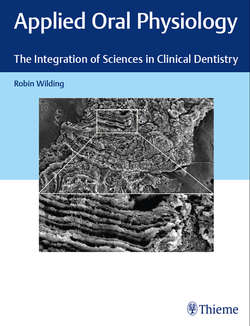Читать книгу Applied Oral Physiology - Robin Wilding - Страница 41
На сайте Литреса книга снята с продажи.
3.3.1 Masticatory Mucosa
ОглавлениеMasticatory mucosa is a descriptive term for the mucoperiosteum, which forms most of the gingiva and covers the hard palate. It is hard enough to resist the abrasion of coarse and rough food particles. It is also firmly attached to the alveolar bone and teeth so that little displacement occurs when a tough food bolus slides down the tooth. Edentulous patients, who have no dentures, are often able to chew directly onto their masticatory mucosa covering the residual alveolar ridges without causing any damage; they also make such frequent use of the tongue against the palate that the tongue becomes larger and more muscular than usual.
Gingiva: The part of the masticatory mucosa which covers the alveolar bone around and in between the teeth is firmly attached to the underlying bone and therefore referred to as attached gingiva. The part of the gingiva which encircles the teeth but is not attached to either tooth or bone is known as the free gingiva. The attached gingiva is usually keratinized, but if it becomes inflamed, it may become nonkeratinized. The more effectively the teeth and gingiva are cleaned, the greater is the tendency for the gingiva to be keratinized. The width of the attached gingiva varies between 4 and 8 mm but is on the average wider in older people. The gingiva is paler pink in color than the mucosa lining the mouth, due to its opacity, but also may be more heavily pigmented with melanin. The junction between the gingiva and the mucosa lining the vestibule and cheeks is noticeable. This mucogingival junction forms a scalloped line around the root eminence of each tooth (▶ Fig. 3.4).
Fig. 3.3 A diagrammatic representation of the distribution of lining, masticatory, and gustatory mucosa.
There is a shallow sulcus (about 2-mm deep) between the free gingiva and the enamel of the tooth, and this sulcus is lined with nonkeratinized epithelium. A probe can normally be inserted into this sulcus to measure the depth without causing bleeding. This sulcus epithelium is continuous with the junctional epithelium, which is a physical attachment or junction between the tooth and its gingiva. When viewed in histological sections, the gingival epithelium has long rete pegs, which represent long and tall ridges penetrating deeply into the lamina propria (▶ Fig. 3.5).
Fig. 3.4 Healthy oral mucosa. The attached gingiva (AG) reveals the contour of the underlying alveolar bone. The broken line marks the mucogingival junction between the attached gingiva and the lining mucosa (LM).
Most of the fibers of the oral mucosa are irregularly arranged, but there are some recognizable gingival fiber groups associated with the fibers of the periodontal ligament (▶ Fig. 3.6). They are named simply by their orientation. Thus, there are a group of fibers connecting the gingiva to the tooth, the so called dentogingival fibers. The ends of the fibers are anchored into the root by being included into cementum. The alveolar crest fibers bind the gingiva to the crest of the alveolar bone surrounding the tooth socket. Another circular group surrounds the tooth and the interdental fibers run between the buccal and lingual papilla between the teeth.
The attached gingiva has a finely pitted or stippled surface due to the insertion of fiber bundles which help bind the lamina propria to the fibers of the periosteum and periodontal ligament.
Collagen fibers are the most essential component of the gingival fiber complex. Reticulin fibers are numerous in the tissue adjacent to the basement membrane and in the tissue surrounding large blood vessels. Oxytalin fibers are present in the connective tissue of the periodontium and appear to be concerned with vascular support. Elastic fibers are only found in gingiva and the periodontium in the connective tissue associated with blood vessels. In the lining mucosa, however, elastic fibers are numerous.
Hard palate: The mucosa of the hard palate is continuous with the gingiva on the palatal side of the maxillary teeth. A pattern of ridges with varying size and shape occurs toward the anterior half of the palate. These ridges are known as rugae and may be as characteristic in their pattern as finger prints. The most anterior feature is the incisive papilla which indicates the position of the incisive foramen. The palatal mucosa has no submucosa and is tightly bound to the palatal periosteum except for an area on either side of the midline, where the submucosa contains fat and more posteriorly, the palatine mucous glands. It also contains the palatine arteries, veins, and nerves.
Fig. 3.5 A diagrammatic representation of the epithelial attachment to the tooth. The junctional epithelium is a continuation of the sulcus epithelium but is physically attached to enamel by hemidesmosomes. Note the relationship between the cementoenamel junction (CEJ) and the crest of the alveolar bone. C, cementum; D, dentin; E, enamel.
Fig. 3.6 A diagrammatic representation of the gingival fiber attachment to the tooth and alveolar bone. The dentogingival fibers are anchored into the root by cementum. The alveolar crest fibers secure the gingiva to the alveolar bone. Circular gingival fibers provide a firm cuff around the tooth, holding the attached gingiva to the tooth. C, cementum; D, dentin; E, enamel.
